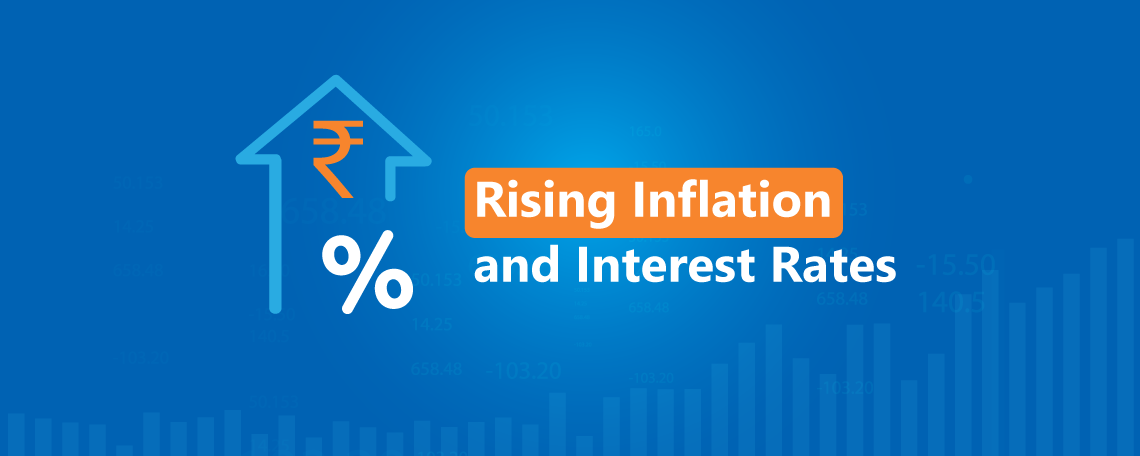Rising Inflation and Interest Rates
June 10, 2022

Stock market volatility has been present all year and it does not seem to be going away anytime soon. This is because Investors have been weighing a long list of uncertainties in the current environment. Such as how quickly the Reserve bank will raise rates, whether or when will the inflation moderate, how long will Russia’s war continue, will the war escalate and turn global and if the pandemic is truly over.
Today we intend to shed some light on questions that have been raiding the minds of investors all over the nation. Expectations surrounding inflation and interest rate policy are changing quickly. But what does this mean for the stock market? The Indian economy has continued to grow despite the headwinds. but can the growth last? And most importantly, are Indian corporates changing their earnings outlooks in light of all of the uncertainty?
While Russia’s Ukrainian war continues to disrupt commodity markets and weighs heavily on sentiment, history tells us that the stock market has usually bounced back once a conflict breaks out. A market rally happens after conflict begins not because armed combat is positive for the economy, but because fighting ends the uncertainty surrounding a possible war. Confirmation of war allows markets to move past the uncertainty and to weigh the downstream effects of the conflict and associated economic sanctions in order to determine whether these effects might be significant enough to trigger a global recession. We have witnessed that from the day of the invasion to the end of the quarter, all the sectors have moved higher and the broad index has rallied by +7%.
Hence, we continue to believe that the risk of a recession and bear market in 2022 remains low even after taking into account the war’s detrimental effects on commodities and supply chains. However, it is clear that investors should brace for more market volatility as more choppiness seems likely in the weeks ahead.
It is our understanding that the stock market is heavily driven by two forces: 1) How corporate earnings grow relative to expectations and 2) how interest rates change relative to expectations. A shifting outlook for inflation and interest rates in 2022 and beyond seems to be driving the majority of the current volatility. The market seems to be weighing the real impact of potential rate hikes on earnings growth. While we don’t want to panic in the face of inflation, we do want to acknowledge its impacts. As inflation erodes the future value of earnings, it can make it difficult for the market to gauge the current value of the companies that make up market indexes. Furthermore, higher prices for materials, inventory and labour can impact earnings as companies adjust. As a result, stock prices can fluctuate and this causes volatility.
Many factors contribute to stock market performance and inflation is just one of them. Inflation is not just limited to food and energy. CPI is rising in virtually all categories from goods to services to home prices and rent. In the wake of the war, commodity prices have surged across many different categories such as oil, natural gas, palladium, wheat, and fertilizer. Shortages of some commodities and rising prices across the board have already begun to reverberate across the global economy leading to even more inflationary pressures and supply chain issues.
However, it is worth noting that historically periods of high inflation have seen both positive and negative stock market returns. If we observe the past 50 years there have been nine periods when the FED entered a cycle of raising the benchmark FED funds rate and stocks did well in eight of them. In fact, the S&P 500’s average annualized returns during the tightening cycles were a stout +11.8%. While this data point does not tell us that stocks will go up during the current tightening cycle, it does provide a pretty clear indication that stocks have not responded adversely to rising rates in the past.
In fact, we would advise that you keep in mind that inflation is the reason why we invest in the stock market. While it is natural to feel caught off guard by the recent price surge, remember that by investing in the stock market you have already been preparing for this very moment. From 1914 to 2022, inflation in the US has averaged 3.25% annually. The S&P 500 Index on the other hand has had an average annual return of 10.49% from 1926 through 2021. Investors that have stayed invested over the long term haven’t just been keeping up with inflation but have been actually building wealth.
While inflation is by no means entirely positive for the stock market, it tends to hurt stocks less than it hurts bonds. As a result, what we are seeing is a rotation out of fixed income into equities and out of growth stocks (which are hurt more by rising interest rates) and into value stocks. The whole situation is somewhat similar to the 1999-2001 market period during which a rising interest rate environment caused violent moves into and out of technology companies while there was an overall trend to sell technology or growth and buy value. It appears that we may be entering a similar period wherein the P/E multiple applied to the earnings of growth companies comes under pressure due to a tightening by the Federal Reserve.
As far as India is concerned, it has less exposure to Russia than almost every other major economy. The employment data is accelerating thereby supporting incomes and consumption. Corporations continue to invest in software and IT and households (in aggregate) have experienced a sharp increase in wealth over the past few years. Corporates are flush with cash and have been investing at a solid clip. It is no surprise that businesses have spent the most on software and Information-processing as the need to ‘digitize’ business operations was catalyzed during the pandemic. Spending in this area of IT rose significantly & is bound to grow as remote work becomes the norm.
Inflationary pressure remains broad-based led by supply shocks. In India, Fuel excise cuts & other steps taken by the government can help ease inflation. As widely expected, RBI has increased the repo rate by 50 bps to 4.90% in its fight to contain the soaring inflation. However, it must be noted that the Repo rate still remains at the pre-pandemic level. The recovery in domestic economic activity remains firm with urban demand recovering & rural demand gradually improving.
The overall earnings picture has been very strong and while the pace of earnings growth is likely to decelerate in coming quarters, it is important to remember that it is coming off very high comparisons with 2021.
At StockAxis, our goal is to offer you smart investment solutions based on your specific financial situation. Therefore, we would like to offer you the unique opportunity to speak to one of our research analysts in order to thoroughly analyze your current investment portfolio and to better understand your investment objectives. After performing a detailed analysis of your portfolio, we shall present you with recommendations for the best investment approach and strategy that we think is possible. Moreover, we will do this for you at no charge and with absolutely no obligation on your part.
Kindly note that we are offering this opportunity for a free portfolio analysis – as well as the chance to speak with a member of our research team – for a short time only and with limited availability. What are you waiting for? Click here to submit your portfolio & transform your financial future. Happy Investing!








